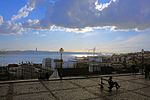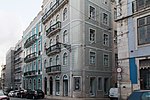Atelier-Museu Júlio Pomar
European museum stubsMuseums in LisbonPortuguese building and structure stubsÁlvaro Siza Vieira buildings
The Atelier-Museum Júlio Pomar is a museum in Lisbon, Portugal, that preserves and promotes the work of Júlio Pomar (1926–2018) through temporary exhibitions, events, conferences, and educational activities. Located between Bairro Alto and Madragoa, two of the city's most popular neighborhoods, the museum building was designed by architect Álvaro Siza (Matosinhos, 1933), winner of the 1992 Pritzker Architecture Prize. The museum's holdings include approximately 1,500 works by Júlio Pomar and other artists who were close to him.
Excerpt from the Wikipedia article Atelier-Museu Júlio Pomar (License: CC BY-SA 3.0, Authors).Atelier-Museu Júlio Pomar
Rua do Vale, Lisbon
Geographical coordinates (GPS) Address Website External links Nearby Places Show on map
Geographical coordinates (GPS)
| Latitude | Longitude |
|---|---|
| N 38.71129 ° | E -9.15042 ° |
Address
Atelier-Museu Júlio Pomar
Rua do Vale 7
1200-472 Lisbon
Portugal
Open on Google Maps







